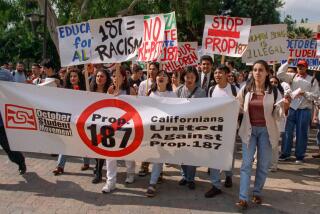State Census Sampling Shows Huge Undercount
Census 2000 failed to count 509,012 Californians, more than half of them in the Southland, according to a set of much-debated, statistically revised figures released Friday by the U.S. Census Bureau.
Almost 300,000 of those overlooked were Latino, the agency said. More than 25% were children.
Census Bureau officials say they do not have confidence in the accuracy of the adjusted numbers, which use sampling to account for people who may have been missed or recorded twice in the conventional mail-in and door-to-door count. They released the figures under a court order.
Nonetheless, the new figures revived complaints by Los Angeles and other large cities that the official 2000 head count, frozen early last year for election redistricting purposes, cost them billions in federal and state funds, which are allocated mostly on the basis of population.
Los Angeles officials say the city will be shortchanged by $186 million over the next 10 years, for everything from school lunches to aid for senior citizens.
“The numbers are not just theoretical stuff,” Assistant City Atty. Jessica Heinz said. “They really translate into services in the community.”
The adjusted count gave five Southern California counties -- Los Angeles, Orange, Riverside, San Bernardino and Ventura -- an additional 261,518 residents, cumulatively. On paper, Los Angeles’ population grew by 2%, adding another 75,000 people, two-thirds of them Latino.
“The census needs to utilize this information to identify the areas that are hard to count,” said Leo Estrada, a professor in UCLA’s urban planning department. “Everything they’ve tried in the past probably did make a difference, but some parts of major urban areas need to be approached differently.”
Historically, affluent older whites have been most likely to be double-counted, in part because of vacation homes and other dual residences. By contrast, Latinos and African Americans have been most likely to be overlooked.
The adjusted 2000 counts affirm the pattern: California’s uncounted white population amounted to just 0.6%, while 2.7% of Latinos and 2.8% of African Americans were missed, according to the sampling. Those differences worry some population analysts.
“Even though some people don’t like to talk about this, race and ethnicity can often be proxies for greater need in some areas,” said Terri Ann Lowenthal, a consultant on the census and federal statistical issues. “We know that a greater proportion of African American children are poor. If we are missing larger numbers of African American kids in the census, clearly there may be a greater need for certain programs, like free or reduced[-cost] school lunches, than the official census figures reflect.”
Such issues have put a political charge into the debate over which census snapshot should be official, with Republicans favoring the original and Democrats the adjusted version. Though the Census Bureau tabulated the adjusted totals early last year, the Bush administration had resisted releasing them, saying they were highly inaccurate. A Freedom of Information Act lawsuit by 16 federal lawmakers led to the court order compelling the adjusted data’s release.
More to Read
Sign up for Essential California
The most important California stories and recommendations in your inbox every morning.
You may occasionally receive promotional content from the Los Angeles Times.










